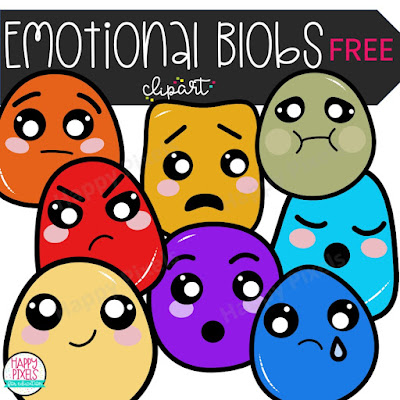In today's technology-driven world, educators are constantly seeking innovative ways to engage their students and make learning more interactive.
One tool for student engagement strategies is clipart for the classroom.
Often underestimated, clipart can be a powerful resource for teachers across various subjects, including language, math, science, health, physical education, social studies, and self-regulation.
In this blog post, we will explore the benefits of using clipart in the classroom and provide practical strategies and examples to help teachers integrate it effectively.
Visual Representation: Clipart provides students with visual representations of concepts, making abstract ideas more tangible and easier to understand. Visual aids have been proven to enhance comprehension and retention, making clipart an ideal resource for diverse learners.
Engagement and Motivation: Clipart adds an element of fun and excitement to lessons, capturing students' attention and boosting their enthusiasm for learning. It can help create a lively and interactive classroom environment that encourages active participation.
Differentiation: Clipart can be tailored to accommodate varying learning styles and abilities. By using a range of visuals, teachers can present information in multiple formats, making it more accessible to all students and catering to individual needs.
Memory Aid: Clipart images, when used strategically, can serve as memory triggers. Associating visual cues with information helps students recall key concepts more easily during assessments and beyond, reinforcing long-term learning.
Student Engagement Strategies with Clipart:
Language: Topic: Vocabulary Development Strategy: Create Word Walls Example: In a language classroom, teachers can use clipart to create word walls with visual representations of vocabulary words. These visual aids will assist students in making connections between the words and their meanings, aiding in language acquisition and retention.
Math: Topic: Geometry Strategy: Shape Sorting and Classification Example: Teachers can use clipart images of different shapes to engage students in sorting and classifying activities. Students can categorize shapes based on attributes such as the number of sides or angles, reinforcing their understanding of geometric concepts.
Science: Topic: Plant Life Cycle Strategy: Sequencing Activities Example: Clipart depicting various stages of a plant's life cycle can be used to create sequencing activities. Students can arrange the images in the correct order, facilitating their understanding of the plant growth process.
Health: Topic: Healthy Habits Strategy: Visual Prompts Example: Teachers can use clipart images to create visual prompts that promote healthy habits, such as washing hands, eating balanced meals, and exercising regularly. These visuals serve as reminders for students to adopt and maintain healthy behaviors.
Physical Education: Topic: Exercise and Fitness Strategy: Exercise Stations Example: Teachers can display clipart images representing different exercises at exercise stations around the gym or classroom. Students can rotate through the stations, engaging in each exercise as instructed by the visuals, promoting physical activity and coordination.
Social Studies: Topic: Community Helpers Strategy: Role-Playing and Matching Activities Example: Clipart depicting various community helpers can be used for role-playing activities, where students dress up and act out different professions. Teachers can also create matching activities where students match clipart images with the respective community helper names, fostering understanding and appreciation of diverse occupations.
Self-Regulation: Topic: Emotion Recognition Strategy: Emotion Cards Example: Teachers can use clipart images representing different emotions to create emotion cards. Students can practice identifying and expressing emotions by selecting the appropriate cards, facilitating self-regulation and emotional intelligence.
Here are some free emotions clipart to use in your classroom (or in your resources, if you're a teacher-author).
Where can you get Clipart for the Classroom?
Teachers can find free clipart from various online sources. Here are some popular websites where educators can access a wide range of free clipart:
Pixabay (https://pixabay.com/): Pixabay is a platform that offers a diverse selection of high-quality clipart images. Pixabay is a vibrant community of creatives, sharing royalty-free images, videos, audio and other media. All content is released by Pixabay under the Content License, which makes it safe to use without asking for permission or giving credit to the artist - even for certain commercial purposes.
Freepik (https://www.freepik.com/): Freepik is a popular resource for free graphic resources, including clipart. While some content on Freepik may require attribution, it offers a wide range of high-quality clipart options for teachers.
Microsoft Office Online (https://templates.office.com/): Microsoft Office Online provides a variety of clipart options within its applications. In Microsoft Word, PowerPoint, or Publisher, you can access clipart libraries by selecting the "Insert" tab and choosing "Clip Art" or "Online Pictures."
Remember to check the usage rights and licensing agreements for each clipart image you use to ensure compliance with copyright restrictions. Additionally, some websites may offer premium content alongside their free options, so be sure to select the free clipart resources.
By utilizing these websites, teachers can find a wealth of free clipart resources to enhance their classroom materials and create engaging learning experiences for their students.
Enhance Student Engagement with Clipart
By incorporating clipart visuals into classroom activities, teachers can enhance student engagement and comprehension across various subjects. Whether it's creating word walls, sequencing activities, or fostering self-regulation skills, clipart provides a versatile tool for educators to make learning more interactive, accessible, and enjoyable. So, let's harness the power of clipart and unlock the full potential of our classrooms!



).png)
No comments
Post a Comment